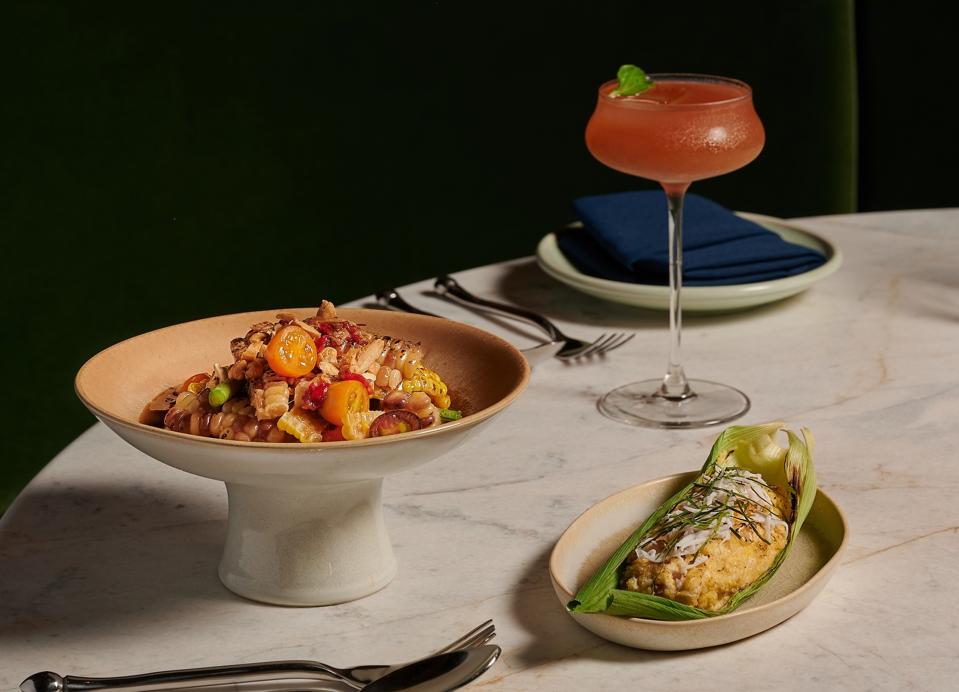Flavors rarely seen outside of Thailand are now available in Manhattan.
Narkara opened at 5 East 17th Street (formerly Union Fare) in early fall. The 150-seat restaurant is the latest project from Kinnaree Hospitality Group (Thep, Viv), offering street food and specialties from Northern and Northeastern Thailand. Chef Sakdiphat Mokkasak (formerly of Pongsri and Pye Boat Noodle), runs the kitchen.
“Narkara is about showing a side of Thailand that people rarely see, the unseen taste of Thailandm” says Rocky Romruen, Managing Director and Co-Founder of Kinnaree Hospitality Group. “It is deeply personal, but also our way of introducing guests to something beautiful, cultural, and new.”
Narkara’s dining room features custom bamboo installations by Korakot Aromdee, a globally celebrated artist renowned for his architectural work with sustainable bamboo, and woven partitions by Patapian, which merges traditional Thai weaving with contemporary design. Custom ceramic tableware crafted by Prempracha and Earth and Fire Ceramics, staff uniforms designed Bangkok designer Ek Thongprasert, ties back to Thai culture.
“We are in a time of elevated authenticity, where chefs are staying true to traditional flavors but expressing them through modern craftsmanship and presentation,” said Romruen. “I think that is where Thai cuisine in New York is heading, and we hope Narkara can be part of that evolution, acting as a cultural bridge that connects our traditions with today’s dining culture in a genuine, thoughtful way.”
What to eat at Narkara
Narkara specializes in regional Thai dishes from the North and Northeast of the country, rarely served at restaurants outside of Thailand.
“Each dish tells a story of Thailand’s regions while reflecting how we like to express Thai flavors today: authentic, creative, and elevated,” says Romruen.
Romruen recommends trying the Kaeng Kradang, a chilled red curry terrine. This Northern Thai delicacy is made with slow-simmered pork red curry, which is then set into a savory chilled terrine. “It is aromatic, rich, and uniquely textured,” he says.
The Kanom Krok Pu are crisp coconut pancakes topped with fresh crab, spicy chili jam, and aromatic kaffir lime, a refined take on a street snack popular in Thailand.
Ong Mun Pu, crab butter custard, is a silken crab tomalley custard served with Khao Jee Pu, grilled sticky rice filled with crab meat. “We add a touch of Hokkaido uni to bring balance and refinement to the natural sweetness of the crab,” Romruen says.
For a heartier dish, the Kua Kae Ped, duck breast stir-fried with Thai eggplant, long beans, herbs, and toasted rice, is a standout.
Pla Abb, roasted sea bass in banana leaf is a must try according to Romruen. Chilean sea bass is marinated with Thai herbs, wrapped in banana leaf and roasted until lightly smoky and super fragrant.
“It is a dish that really captures what Narkara is about: balance, aroma, and respect for ingredients,” says Romruen. “It is simple but deeply flavorful, and it feels like something you would find in Thailand, presented in a way that feels elegant here in New York.”
To drink, Narkara’s beverage program is centered around classic cocktails reenvisioned with Thai flavors and ingredients. The Makwaen Penicillin is made with makwaen pepper–infused scotch, mezcal, Drambuie, dry vermouth, and galangal syrup. The Rice Paddy Herb Martini with jasmine green tea gin, rice paddy herb–infused dry vermouth, and maraschino. And Kaffir Lime Diablo is a tropical reimagining of the El Diablo made with house-infused kaffir lime tequila, rum, and ginger liqueur, and Lychee 75, a riff on the classic cocktail with Vietnamese coriander gin, Strega, house lychee syrup, lemon, absinthe, and sparkling wine.
“The future of Thai food in New York is very exciting. There are so many Thai restaurants opening right now with new concepts and ideas, each showing a different side of Thailand that people here have not seen before,” said Romruen. “As a Thai person, I feel proud of that.”

